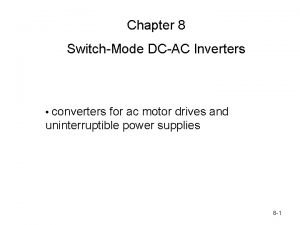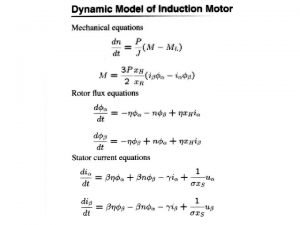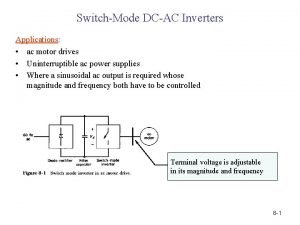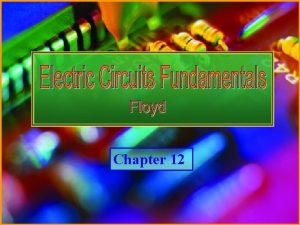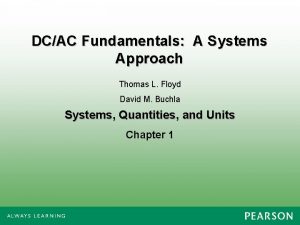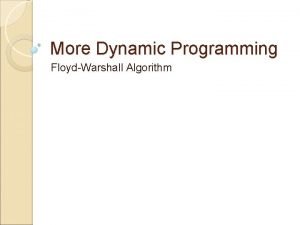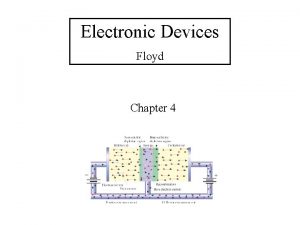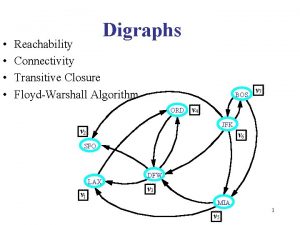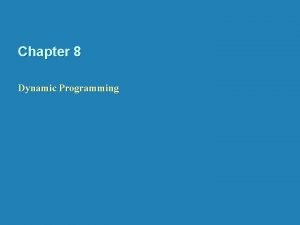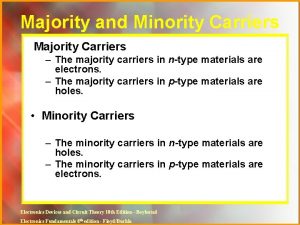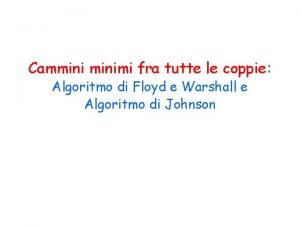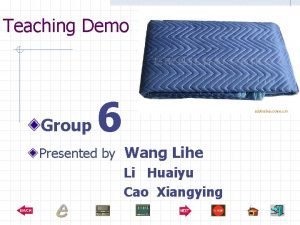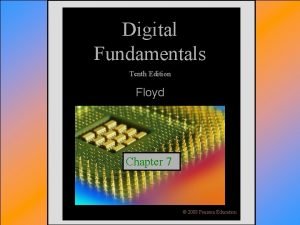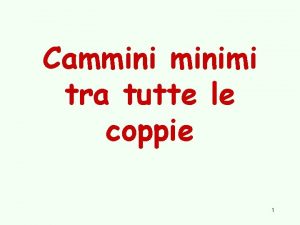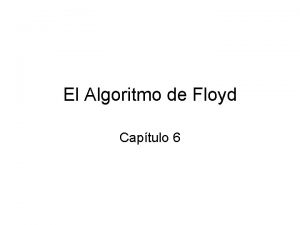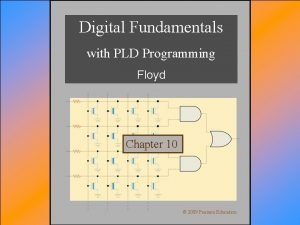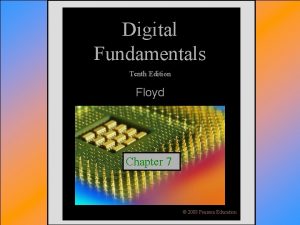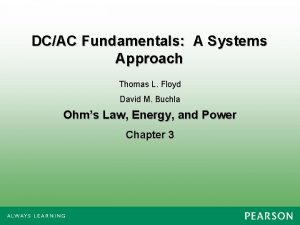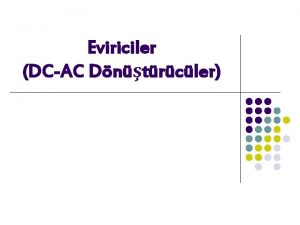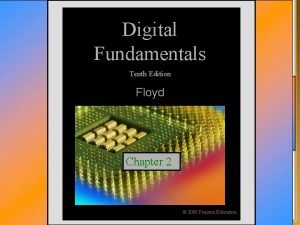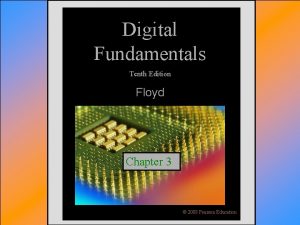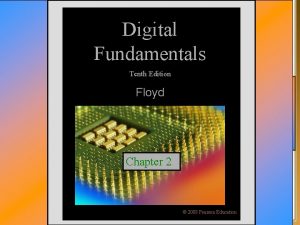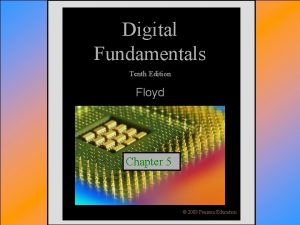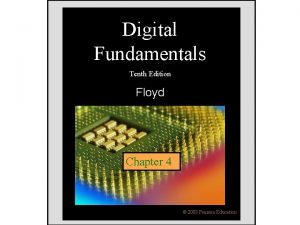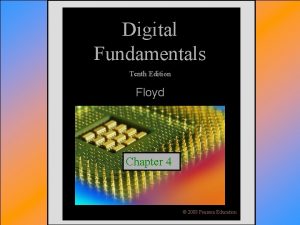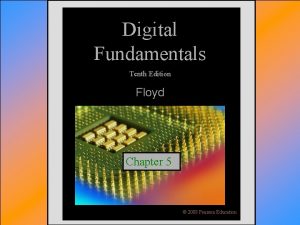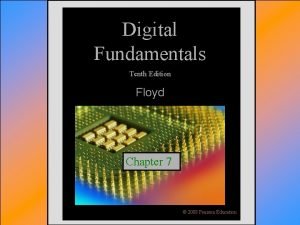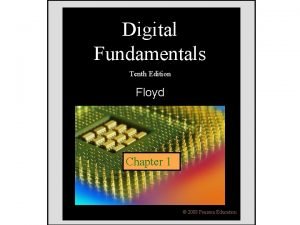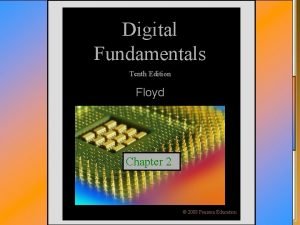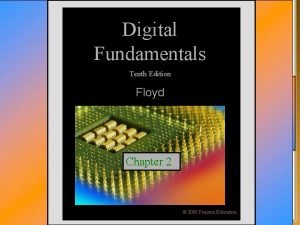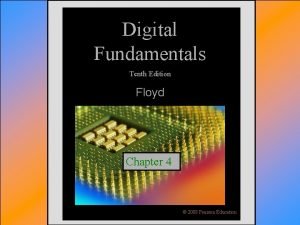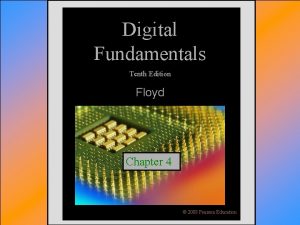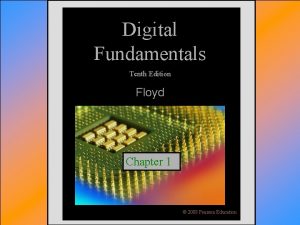DCAC Fundamentals A Systems Approach Thomas L Floyd















































- Slides: 47

DC/AC Fundamentals: A Systems Approach Thomas L. Floyd David M. Buchla Systems, Quantities, and Units Chapter 1

Ch. 1 Summary Systems A system is a group of interrelated parts that perform a specific function. A system communicates with the outside world via its inputs and outputs. An input is the voltage, current or power that is applied to an electrical circuit to achieve a desired result. An output is the result obtained from the system after processing its input(s). DC/AC Fundamentals: A Systems Approach Thomas L. Floyd © 2013 by Pearson Higher Education, Inc Upper Saddle River, New Jersey 07458 • All Rights Reserved

Ch. 1 Summary Electrical and Electronic Systems An electrical system deals with electric power. Examples: Residential wiring systems, heating, ventilation, and airconditioning (HVAC) systems, and utility lighting systems. An electronic system deals with signals; changing electrical or electromagnetic quantities that carry information. Examples: Personal computers, smart phones, television systems DC/AC Fundamentals: A Systems Approach Thomas L. Floyd © 2013 by Pearson Higher Education, Inc Upper Saddle River, New Jersey 07458 • All Rights Reserved

Ch. 1 Summary Block Diagrams A block diagram is a model of a system that represents its structure in a graphical format using labeled blocks to represent functions and lines to represent the signal flow. DC/AC Fundamentals: A Systems Approach Thomas L. Floyd © 2013 by Pearson Higher Education, Inc Upper Saddle River, New Jersey 07458 • All Rights Reserved

Ch. 1 Summary Types of Components • Passive components • Active components DC/AC Fundamentals: A Systems Approach Thomas L. Floyd © 2013 by Pearson Higher Education, Inc Upper Saddle River, New Jersey 07458 • All Rights Reserved

Summary Passive Components • Resistors DC/AC Fundamentals: A Systems Approach Thomas L. Floyd © 2013 by Pearson Higher Education, Inc Upper Saddle River, New Jersey 07458 • All Rights Reserved

Summary Passive Components • Capacitors DC/AC Fundamentals: A Systems Approach Thomas L. Floyd © 2013 by Pearson Higher Education, Inc Upper Saddle River, New Jersey 07458 • All Rights Reserved

Summary Passive Components • Inductors DC/AC Fundamentals: A Systems Approach Thomas L. Floyd © 2013 by Pearson Higher Education, Inc Upper Saddle River, New Jersey 07458 • All Rights Reserved

Summary Passive Components • Transformers DC/AC Fundamentals: A Systems Approach Thomas L. Floyd © 2013 by Pearson Higher Education, Inc Upper Saddle River, New Jersey 07458 • All Rights Reserved

Summary Active Components Passive components are used in conjunction with active components to form an electronic system. Active components will be the subject of future courses. • Transistors • Integrated Circuits DC/AC Fundamentals: A Systems Approach Thomas L. Floyd © 2013 by Pearson Higher Education, Inc Upper Saddle River, New Jersey 07458 • All Rights Reserved

Ch. 1 Summary Types of Circuits An electrical circuit must form a complete path from a power or signal source to a load, and back to the source. A circuit that forms a complete loop (as described above) is called a closed circuit. A circuit that does not form a complete loop is called an open circuit. Circuits contain components; devices that alter one or more electrical characteristics of the power or signal input. DC/AC Fundamentals: A Systems Approach Thomas L. Floyd © 2013 by Pearson Higher Education, Inc Upper Saddle River, New Jersey 07458 • All Rights Reserved

Ch. 1 Summary Fundamental Units Quantity Unit Symbol Meter m Mass Kilogram kg Time Second s Electric Current Ampere A Kelvin K Candela cd Length Temperature Luminous intensity Amount of substance DC/AC Fundamentals: A Systems Approach Thomas L. Floyd Mole mol © 2013 by Pearson Higher Education, Inc Upper Saddle River, New Jersey 07458 • All Rights Reserved

Summary Some Important Electrical Units Except for current, all electrical and magnetic units are derived from the fundamental units. Current is a fundamental unit. Quantity Current Charge Voltage Resistance Power DC/AC Fundamentals: A Systems Approach Thomas L. Floyd Unit Symbol Ampere Coulomb Volt Ohm Watt A C V W W © 2013 by Pearson Higher Education, Inc Upper Saddle River, New Jersey 07458 • All Rights Reserved

Ch. 1 Summary Some Important Electrical Units Except for current, all electrical and magnetic units are derived from the fundamental units. Current is a fundamental unit. Quantity Unit Symbol Current Ampere A Charge Coulomb C Voltage Volt V Resistance Ohm W Power Watt W DC/AC Fundamentals: A Systems Approach Thomas L. Floyd These derived units are based on fundamental units from the meterkilogram-second system and are called mks units. © 2013 by Pearson Higher Education, Inc Upper Saddle River, New Jersey 07458 • All Rights Reserved

DC/AC Fundamentals: A Systems Approach Thomas L. Floyd © 2013 by Pearson Higher Education, Inc Upper Saddle River, New Jersey 07458 • All Rights Reserved

Summary Some Important Magnetic Units All magnetic units are derived from the fundamental units. These units are discussed in Chapter 10. Quantity Symbol Unit Magnetic field intensity Magnetic flux density Magnetomotive force Permeability Reluctance DC/AC Fundamentals: A Systems Approach Thomas L. Floyd H f B Fm m R Ampere-turns/meter Weber Tesla Ampere-turn Webers/ampere-turns-meter Ampere-turns/weber Symbol At/m Wb T At Wb/At. m At/Wb © 2013 by Pearson Higher Education, Inc Upper Saddle River, New Jersey 07458 • All Rights Reserved

Summary Scientific and Engineering Notation Very large and very small numbers are represented with scientific and engineering notation. 47, 000 = 4. 7 x 107 (Scientific Notation) = 47. x 106 (Engineering Notation) DC/AC Fundamentals: A Systems Approach Thomas L. Floyd © 2013 by Pearson Higher Education, Inc Upper Saddle River, New Jersey 07458 • All Rights Reserved

Summary Scientific and Engineering Notation 0. 000 027 = 2. 7 x 10 -5 (Scientific Notation) = 27 x 10 -6 (Engineering Notation) 0. 605 = 6. 05 x 10 -1 (Scientific Notation) = 605 x 10 -3 (Engineering Notation) DC/AC Fundamentals: A Systems Approach Thomas L. Floyd © 2013 by Pearson Higher Education, Inc Upper Saddle River, New Jersey 07458 • All Rights Reserved

Ch. 1 Summary Scientific and Engineering Notation Very large and very small numbers are represented with scientific and engineering notation. For example, the number forty-seven million can be written as 47, 000 Scientific Notation Engineering Notation 4. 7 x 107 47 x 106 DC/AC Fundamentals: A Systems Approach Thomas L. Floyd © 2013 by Pearson Higher Education, Inc Upper Saddle River, New Jersey 07458 • All Rights Reserved

Ch. 1 Summary Scientific and Engineering Notation Example Scientific Notation Engineering Notation 0. 000027 = 2. 7 x 10 -5 27 x 10 -6 0. 605 = 6. 05 x 10 -1 605 x 10 -3 32600 = 3. 26 x 104 32. 6 x 103 892, 000 = 8. 92 x 105 892 x 103 0. 377 = 3. 77 x 10 1 377 x 10 3 DC/AC Fundamentals: A Systems Approach Thomas L. Floyd © 2013 by Pearson Higher Education, Inc Upper Saddle River, New Jersey 07458 • All Rights Reserved

Ch. 1 Summary Engineering Metric Prefixes Large numbers (>1) Can you name these engineering metric prefixes and their meaning? DC/AC Fundamentals: A Systems Approach Thomas L. Floyd P peta 1015 T tera 1012 G giga 109 M mega 106 k kilo 103 © 2013 by Pearson Higher Education, Inc Upper Saddle River, New Jersey 07458 • All Rights Reserved

Ch. 1 Summary Engineering Metric Prefixes Small numbers (<1) Can you name these engineering metric prefixes and their meaning? DC/AC Fundamentals: A Systems Approach Thomas L. Floyd m milli 10 -3 m micro 10 -6 n nano 10 -9 p pico 10 -12 f femto 10 -15 © 2013 by Pearson Higher Education, Inc Upper Saddle River, New Jersey 07458 • All Rights Reserved

DC/AC Fundamentals: A Systems Approach Thomas L. Floyd © 2013 by Pearson Higher Education, Inc Upper Saddle River, New Jersey 07458 • All Rights Reserved

Ch. 1 Summary Metric Conversions When converting from one unit to a smaller unit, move the decimal point to the right. Remember, a smaller unit means the number must be larger. Smaller unit 0. 47 MW = 470 k. W Larger number DC/AC Fundamentals: A Systems Approach Thomas L. Floyd © 2013 by Pearson Higher Education, Inc Upper Saddle River, New Jersey 07458 • All Rights Reserved

Ch. 1 Summary Metric Conversions When converting from one unit to a larger unit, move the decimal point to the left. Remember, a larger unit means the number must be smaller. Larger unit 10, 000 p. F = 0. 01 m. F Smaller number DC/AC Fundamentals: A Systems Approach Thomas L. Floyd © 2013 by Pearson Higher Education, Inc Upper Saddle River, New Jersey 07458 • All Rights Reserved

Ch. 1 Summary Metric Arithmetic When adding or subtracting numbers with a metric prefix, convert them to the same prefix first. 10, 000 W + 22 k. W = 10, 000 W + 22, 000 W = 32, 000 W Alternatively: 10 k. W + 22 k. W = 32 k. W DC/AC Fundamentals: A Systems Approach Thomas L. Floyd © 2013 by Pearson Higher Education, Inc Upper Saddle River, New Jersey 07458 • All Rights Reserved

Ch. 1 Summary Metric Arithmetic When adding or subtracting numbers with different metric prefixes, convert them to the same prefix first. 200 m. A + 1. 0 m. A = 200 m. A + 1, 000 m. A = 1200 m. A Alternatively: DC/AC Fundamentals: A Systems Approach Thomas L. Floyd 0. 200 m. A + 1. 0 m. A = 1. 2 m. A © 2013 by Pearson Higher Education, Inc Upper Saddle River, New Jersey 07458 • All Rights Reserved

Ch. 1 Summary Error, Accuracy and Precision Experimental uncertainty is part of all measurements. Error is the difference between the true or best accepted value and the measured value. Accuracy is an indication of the range of error in a measurement. Precision is a measure of repeatability } Error DC/AC Fundamentals: A Systems Approach Thomas L. Floyd Precise, but not accurate. © 2013 by Pearson Higher Education, Inc Upper Saddle River, New Jersey 07458 • All Rights Reserved

Ch. 1 Summary Error, Accuracy and Precision When reporting a measured value, one uncertain digit may be retained, but other uncertain digits should be discarded. Normally this is the same number of digits as in the original measurement. Assume two measured quantities are 10. 54 and 3. 92. If the larger is divided by the smaller, the answer is … 2. 69 Why? Because the answer has the same uncertainty as the original measurement. DC/AC Fundamentals: A Systems Approach Thomas L. Floyd © 2013 by Pearson Higher Education, Inc Upper Saddle River, New Jersey 07458 • All Rights Reserved

Ch. 1 Summary When Is A Digit Considered Significant? The rules for determining if a specified digit is significant are: 1. Nonzero digits are always considered to be significant. 2. Zeros to the left of the first nonzero digit are never significant. 3. Zeros between nonzero digits are always significant. 4. Zeros to the right of the decimal point are considered significant when followed by nonzero digits. 5. Zeros to the left of the decimal point with a whole number may or may not be significant, depending on the measurement. DC/AC Fundamentals: A Systems Approach Thomas L. Floyd © 2013 by Pearson Higher Education, Inc Upper Saddle River, New Jersey 07458 • All Rights Reserved

Ch. 1 Summary Examples 1. Non-zero digits are always considered to be significant. 23. 92 has four non-zero digits – they are all significant. 2. Zeros to the left of the first non-zero digit are never significant. 0. 00276 has three zeros to the left of the first non-zero digit. There are only three significant digits. 3. Zeros between nonzero digits are always significant. 806 has three significant digits. 4. Zeros to the right of the decimal point for a decimal number are significant. 9. 00 has three significant digits. 5. Zeros to the left of the decimal point with a whole number may or may not be significant depending on the measurement. 4000 does not have a clear number of significant digits. DC/AC Fundamentals: A Systems Approach Thomas L. Floyd © 2013 by Pearson Higher Education, Inc Upper Saddle River, New Jersey 07458 • All Rights Reserved

Ch. 1 Summary Rounding Numbers Rounding is the process of discarding meaningless digits. The rules for rounding are: 1. If the dropped digit is greater than 5, increase the last retained digit by 1. 2. If the dropped digit is less than 5, do not change the last retained digit. 3. If the dropped digit is 5, increase the last retained digit if it makes it even, otherwise do not. This is called the "round-to-even" rule. DC/AC Fundamentals: A Systems Approach Thomas L. Floyd © 2013 by Pearson Higher Education, Inc Upper Saddle River, New Jersey 07458 • All Rights Reserved

Ch. 1 Summary Utility voltages and GFCI Most laboratory equipment is connected to 120 Vrms at the outlet. Wiring to the outlets generally uses three insulated wires which are referred to as the “hot” (black or red wire), neutral (white wire), and safety ground (green wire). Neutral GFCI circuits can detect a difference in the hot and Ground neutral current and trip a breaker. One outlet on the circuit will have reset and test buttons. DC/AC Fundamentals: A Systems Approach Thomas L. Floyd Hot © 2013 by Pearson Higher Education, Inc Upper Saddle River, New Jersey 07458 • All Rights Reserved

Ch. 1 Summary Electrical Safety is always a concern with electrical circuits. Knowing the rules and maintaining a safe environment is everyone’s job. A few important safety suggestions are: • • Do not work alone, or when you are drowsy. Do not wear conductive jewelry. Know the potential hazards of the equipment you are working on; check equipment and power cords frequently. Avoid all contact with energized circuits; even low voltage circuits. Maintain a clean and uncluttered workspace. Know the location of power shutoff and fire extinguishers. Don’t have food or drinks in the laboratory or work area. DC/AC Fundamentals: A Systems Approach Thomas L. Floyd © 2013 by Pearson Higher Education, Inc Upper Saddle River, New Jersey 07458 • All Rights Reserved

Ch. 1 Summary Key Terms Engineering notation Exponent A system for representing any number as a one-, two-, or three-digit number times a power of ten with an exponent that is a multiple of three. The number to which a base is raised. Metric prefix A symbol that is used to replace the power of ten in numbers expressed in scientific or engineering notation. Power of ten A numerical representation consisting of a base of 10 and an exponent; the number 10 raised to a power. DC/AC Fundamentals: A Systems Approach Thomas L. Floyd © 2013 by Pearson Higher Education, Inc Upper Saddle River, New Jersey 07458 • All Rights Reserved

Ch. 1 Summary Key Terms Scientific notation A system for representing any number as a number between 1 and 10 times a power of ten. Accuracy An indication of the range of error in a measurement. Precision A measure of the repeatability (consistency) of a series of measurements. Significant digit A digit known to be correct in a number. DC/AC Fundamentals: A Systems Approach Thomas L. Floyd © 2013 by Pearson Higher Education, Inc Upper Saddle River, New Jersey 07458 • All Rights Reserved

Ch. 1 Summary Quiz 1. The number 2. 59 x 107 is expressed in a. scientific notation b. engineering notation c. both of the above d. none of the above DC/AC Fundamentals: A Systems Approach Thomas L. Floyd © 2013 by Pearson Higher Education, Inc Upper Saddle River, New Jersey 07458 • All Rights Reserved

Ch. 1 Summary Quiz 2. The electrical unit that is fundamental is the a. volt b. ohm c. coulomb d. ampere DC/AC Fundamentals: A Systems Approach Thomas L. Floyd © 2013 by Pearson Higher Education, Inc Upper Saddle River, New Jersey 07458 • All Rights Reserved

Ch. 1 Summary Quiz 3. In scientific notation, the number 0. 00056 is expressed as a. 5. 6 x 104 b. 5. 6 x 10 -4 c. 56 x 10 -5 d. 560 x 10 -6 DC/AC Fundamentals: A Systems Approach Thomas L. Floyd © 2013 by Pearson Higher Education, Inc Upper Saddle River, New Jersey 07458 • All Rights Reserved

Ch. 1 Summary Quiz 4. In engineering notation, the number 0. 000 56 is expressed as a. 5. 6 x 104 b. 5. 6 x 10 -4 c. 56 x 10 -5 d. 560 x 10 -6 DC/AC Fundamentals: A Systems Approach Thomas L. Floyd © 2013 by Pearson Higher Education, Inc Upper Saddle River, New Jersey 07458 • All Rights Reserved

Ch. 1 Summary Quiz 5. The metric prefix nano means a. 10 -3 b. 10 -6 c. 10 -9 d. 10 -12 DC/AC Fundamentals: A Systems Approach Thomas L. Floyd © 2013 by Pearson Higher Education, Inc Upper Saddle River, New Jersey 07458 • All Rights Reserved

Ch. 1 Summary Quiz 6. The metric prefix pico means a. 10 -3 b. 10 -6 c. 10 -9 d. 10 -12 DC/AC Fundamentals: A Systems Approach Thomas L. Floyd © 2013 by Pearson Higher Education, Inc Upper Saddle River, New Jersey 07458 • All Rights Reserved

Ch. 1 Summary Quiz 7. The number 2700 MW equals a. 2. 7 TW b. 2. 7 GW c. 2. 7 k. W d. 2. 7 m. W DC/AC Fundamentals: A Systems Approach Thomas L. Floyd © 2013 by Pearson Higher Education, Inc Upper Saddle River, New Jersey 07458 • All Rights Reserved

Ch. 1 Summary Quiz 8. The number 68 k. W equals a. 6. 8 x 104 W b. 68, 000 W c. 0. 068 MW d. All of the above DC/AC Fundamentals: A Systems Approach Thomas L. Floyd © 2013 by Pearson Higher Education, Inc Upper Saddle River, New Jersey 07458 • All Rights Reserved

Ch. 1 Summary Quiz 9. 330 m. W + 1. 5 W = a. 331. 5 m. W b. 3. 35 W c. 1. 533 W d. 1. 83 W DC/AC Fundamentals: A Systems Approach Thomas L. Floyd © 2013 by Pearson Higher Education, Inc Upper Saddle River, New Jersey 07458 • All Rights Reserved

Ch. 1 Summary Quiz 10. Precision is a measurement of a. the total error in a series of measurements b. the consistency of a series of measurements c. both of the above d. none of the above DC/AC Fundamentals: A Systems Approach Thomas L. Floyd © 2013 by Pearson Higher Education, Inc Upper Saddle River, New Jersey 07458 • All Rights Reserved

Ch. 1 Summary Answers 1. a 6. d 2. d 7. b 3. b 8. d 4. d 9. d 5. c 10. b DC/AC Fundamentals: A Systems Approach Thomas L. Floyd © 2013 by Pearson Higher Education, Inc Upper Saddle River, New Jersey 07458 • All Rights Reserved
 Digital fundamentals tenth edition floyd
Digital fundamentals tenth edition floyd Dcac converters
Dcac converters Dcac converters
Dcac converters Dcac lecture series
Dcac lecture series Digital fundamentals floyd ppt
Digital fundamentals floyd ppt Digital fundamentals floyd 10th edition
Digital fundamentals floyd 10th edition Electric circuits fundamentals floyd
Electric circuits fundamentals floyd Dc/ac fundamentals 1st edition
Dc/ac fundamentals 1st edition Forensic anthropologist vs forensic pathologist
Forensic anthropologist vs forensic pathologist Fundamentals of information systems 9th edition
Fundamentals of information systems 9th edition Fundamentals of information systems 9th edition
Fundamentals of information systems 9th edition Fundamentals of information systems chapter 1
Fundamentals of information systems chapter 1 Fundamentals of information systems chapter 1
Fundamentals of information systems chapter 1 Fundamentals of information systems
Fundamentals of information systems Fundamentals of information systems 9th edition
Fundamentals of information systems 9th edition Quality management systems fundamentals and vocabulary
Quality management systems fundamentals and vocabulary Pmt 0140 team management and leadership exam
Pmt 0140 team management and leadership exam Floyd radigan
Floyd radigan The blanket by floyd dell setting
The blanket by floyd dell setting Dijkstra's shortest path algorithm pseudocode
Dijkstra's shortest path algorithm pseudocode Floyd warshall algorithm example
Floyd warshall algorithm example Floyd
Floyd Strongly connected
Strongly connected Floyd warshall algorithm transitive closure
Floyd warshall algorithm transitive closure The blanket by floyd dell questions and answers
The blanket by floyd dell questions and answers Floyd angol együttes
Floyd angol együttes Myofascial release floyd county
Myofascial release floyd county Floyd allport
Floyd allport Amani floyd
Amani floyd Tara misra
Tara misra Belgische powerpoint presentatie pink floyd
Belgische powerpoint presentatie pink floyd Electronic devices floyd 10th edition
Electronic devices floyd 10th edition Algoritmo floyd
Algoritmo floyd All-pairs shortest paths
All-pairs shortest paths Algoritmo de floyd-warshall
Algoritmo de floyd-warshall The blanket by floyd dell symbolism
The blanket by floyd dell symbolism Song about consumerism
Song about consumerism Floyd
Floyd Algoritmo floyd warshall
Algoritmo floyd warshall Sally floyd
Sally floyd Algoritmo de floyd
Algoritmo de floyd Floyd
Floyd Floyd
Floyd Datagram switching and virtual circuit switching
Datagram switching and virtual circuit switching Cognitive approach vs behavioral approach
Cognitive approach vs behavioral approach International market selection model
International market selection model Multiple approach avoidance conflict
Multiple approach avoidance conflict Cognitive approach vs behavioral approach
Cognitive approach vs behavioral approach

